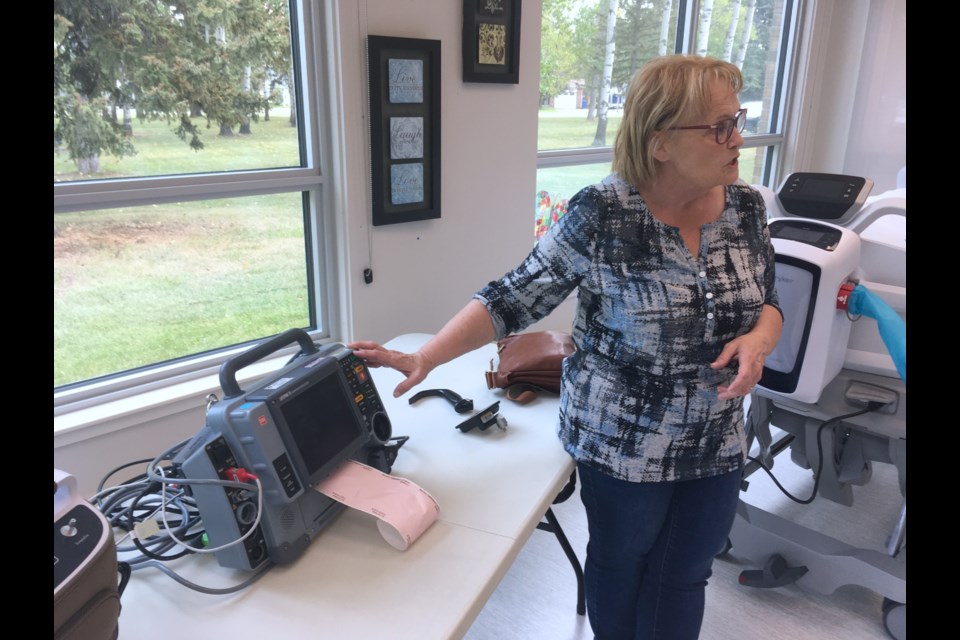SUNDRE – Members of the Sundre Hospital Futures Committee proudly unveiled the new equipment that has been acquired over the past 16 months courtesy of the organization’s third capital campaign fundraiser that ended up exceeding expectations.
“This is all community-funded,” Chantal Crawford, site manager at the Myron Thompson Health Centre, said during an open house barbecue event in recent weeks to promote the acquisitions that both improve patient care and facilitate the work local health-care professionals do every day.
“We have a lot of brand new equipment from the community; it’s been huge,” said Crawford, addressing a crowd attended by dignitaries including Sundre mayor Richard Warnock, Mountain View County Reeve Angela Aalbers, as well as Peggy Johnson, a county councillor and Connie Anderson, Town of Sundre councillor.
“Our community is so giving,” she said.
And while the equipment is put to good use helping plenty of people in the community, many others don’t necessarily always get to see the tangible results of the what the fundraising efforts make possible, she said.
“Their money is actually coming back into the community, and it is to life-saving devices as well,” she said, citing as an example the cardiac monitors that were obtained as a result of the inaugural capital campaign.
The second capital campaign made possible the purchase of a mobile X-Ray machine, she said, adding the third and latest campaign was focused on seniors’ health.
Both the Sundre Hospital Futures Committee and the Sundre Hospital Auxiliary coordinate their efforts to help ensure the facility is well equipped – the former having raised $330,672 and the latter about $184,300 throughout the campaign – while also supporting the Sundre Palliative Care Association’s palliative care room as well as the family waiting room.
During the presentations by Crawford who was also joined by Audrey McKenzie, an RN as well as an educator, the mobile X-Ray machine that was also put on display ended up being rolled out by a nurse for use.
Crawford also mentioned there were some other new items that weren’t brought out and placed on display for the open house because they were in use, such as heated infusion chairs and a new sweep for sidewalks.
Among the lengthy list of items too numerous to mention them all were 18 modern beds, including new bariatric beds that are outfit for the digital age with plugins that enable patients to charge their digital devices as well as Bluetooth functionality to reduce the trip hazard presented by multitudes of cables. Out of those beds, three were purchased by Alberta Health Services, she said.
McKenzie also presented items such as a new screen-equipped glide scope, which are frequently used by physicians.
“If they have to intubate somebody – putting a tube down into their lungs to help them breathe – this just makes it so much easier for them, and less trauma for the patient,” she said.
A disposable device that connect to the scope shows the physician on the screen the interior of the patient’s mouth, she said.
“And then they can just pass the tube and see exactly where they’re going. It makes it so much easier for the patient and the physician,” she said, adding traditional glide scopes did not have screens and that physicians had to rely exclusively on experience and intuition.
“This makes all the difference in the world,” she said.
There was also the new Lifepak 15, a defibrillator device with three different settings depending on a patient’s cardiovascular condition.
“These are used certainly in codes when somebody does not have a heartbeat and we need to defibrillate them,” she said, adding the unit can also be used on a patient with a slow heartbeat to provide a temporary pacemaker until STARS can fly in with a crew with a longer-term device.
“This will pace a patient and keep them alive, and it also will cardiovert somebody that’s running way too fast and it’s putting a lot of stress on the heart,” she said.
“So, three types of shocks we can deliver with this one device.”
There was also three new oxygen concentrators that come in “really handy if a patient wants to go out on a pass and they’re on low amounts of oxygen. We don’t want to send a tank home with them,” she said.
“People smoke around tanks, that’s not good,” she said, adding that pressurized air tanks that accidentally get knocked over can also potentially become hazardous projectiles that launch like missiles.
“And they run out of oxygen quite easily. So, these oxygen concentrators, (patients) can go home on two or three or four litres of oxygen. This isn’t providing them oxygen but it concentrates it, elevates it and it’ll keep them quite comfortable,” she said, adding the units are also much more portable to accommodate errands such as appointments without lugging around a heavier oxygen tank.
Among the many other pieces of equipment presented – including floor lifts and bariatric commode chairs – was a fluid warmer for infusions that is “really important in trauma victims that are coming in and they’ve already lost a lot of blood,” she said.
“We were pumping them with cold fluids and cold blood in the past. So this here, it’s got a little device that we slide in there and connect to our blood or IV tubing, and it just warms it,” she said.
“If we run it over our hands it’s like a warm spa, and that’s what we’re putting into their bodies rather than icy-cold blood out of a fridge, or cold fluids that’s only going to cool their temperature more.”
The Sundre Hospital Futures Committee’s next main event is its annual gala fundraiser, which takes place Saturday, Nov. 16 at the Sundre Community Centre, when the group expects to announce upcoming plans for the next big project.
Offering a sneak peek, Gerald Ingeveld, committee chair, said the gala’s theme this year is “Building For Tomorrow.”
Visit www.sundrehospitalfutures.com for more information.



